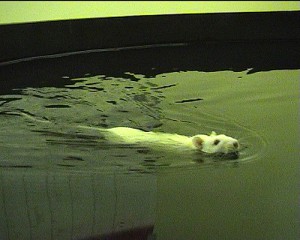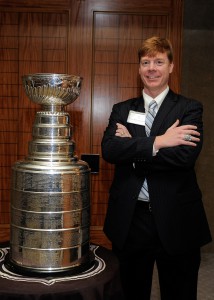On June 6, 2011, the Boston Bruins were playing the Vancouver Canucks in game 3 of the Stanley Cup finals. Bruins forward Nathan Horton had passed the puck to his teammate Milan Lucic when he was blindsided by the Canucks’s Aaron Rome, who buried his left shoulder into Horton’s face. Horton’s head was spun backwards, down towards the ice. The back of his head was the first part of his body to make contact with the ice. He was knocked unconscious. His arms became rigid. His eyes rolled back in his head. He had a convulsion.
Nathan Horton was concussed.
Concussion is all too common in sports, particularly those, like ice hockey, that involve body-to-body collisions. Yet it’s still somewhat of a medical mystery. Until the last 10 to 15 years, few physicians or scientists considered concussion significant enough to warrant scientific investigation. Thus, we know very little about it.
Although the signs and symptoms of a concussion can be profound, as in the case of Nathan Horton, modern medical images of concussed brains, such as CT scans and MRIs, are remarkable only for how normal they are. There’s no bruising, no bleeding, no swelling.
To better understand the implications of concussive brain injuries, I set out with two collaborators, Rebekah Mannix, MD, MPH at Boston Children’s Hospital and Michael Whalen, MD, PhD of Massachusetts General Hospital, to develop a mouse model of concussion under a grant from the National Football League (NFL). This was a difficult task. The mice had to have measurable signs of concussion (poor memory, difficulty learning, loss of consciousness or convulsions), but not a structural brain injury (causing bleeding, swelling or bruising of the brain).

Meehan and colleagues modeled the effects of concussion in mice, having them navigate the classic Morris water maze to measure changes in memory and learning. (This image, from Wikimedia Commons, shows a rat.)
Once we had our model, we first used it to determine whether the effects of concussions are cumulative. Some athletes who sustain multiple concussions during their careers report problems later in life, such as poor memory, blunted reaction time, slowed thinking and difficulty learning. Yet their brain MRIs appear normal, leading some people to question whether anything is truly wrong with these athletes. Some even accuse them of “malingering” — seeking to avoid work, collect disability payments or sue the NFL. Others suggest that these athletes’ problems aren’t due to concussions, but rather to steroid use, alcohol abuse, depression or recreational drug use.
Fortunately, mice don’t malinger, use steroids or engage in substance abuse, making our mouse model of concussion ideal for testing whether repeated concussions can cause problems with memory and learning.
We started by delivering mild concussions-so mild that a single injury had no apparent effect on memory or ability to learn. But with repeated injuries, the mice developed profound learning and memory problems. Thus, our model strongly suggests that multiple, mild concussions affect cognitive function.
Currently, when athletes sustain concussions, they’re removed from play until they recover. Further studies in our mouse model, looking at a series of five concussions, suggest that this practice is beneficial: On tests done shortly after the final injury, mice that sustained monthly concussions performed better than those that sustained their concussions daily.
When we retested their memory one month later, what we found was surprising. While mice that sustained weekly concussions had no statistical difference in their ability to learn and remember than the uninjured mice when tested shortly after their fifth injury, they performed worse than uninjured mice after a one-month recovery period. This suggests that the cognitive effects of sustaining multiple concussions can be delayed.
The lesson here is that the current practice of removing concussed athletes from play-allowing them to recover before exposing them to additional injuries-may protect brain function in the short-term, but may be less effective at preventing the long-term, cumulative effects of repeat concussions.
While we still need to know more about the effects of repeated concussions, especially for young athletes, some things are certain.
The effects are cumulative.
The consequences are real.
 William P. Meehan III, MD, is director of the Micheli Center for Sports Injury Prevention, director of the Sports Concussion Clinic and director of Research for the Brain Injury Center at Boston Children’s Hospital. His research has been funded by the National Institutes of Health, the National Football League and the Center for the Integration of Medicine and Innovative Technology. Meehan is author of the book Kids, Sports, and Concussion: A Guide for Coaches and Parents.
William P. Meehan III, MD, is director of the Micheli Center for Sports Injury Prevention, director of the Sports Concussion Clinic and director of Research for the Brain Injury Center at Boston Children’s Hospital. His research has been funded by the National Institutes of Health, the National Football League and the Center for the Integration of Medicine and Innovative Technology. Meehan is author of the book Kids, Sports, and Concussion: A Guide for Coaches and Parents.






